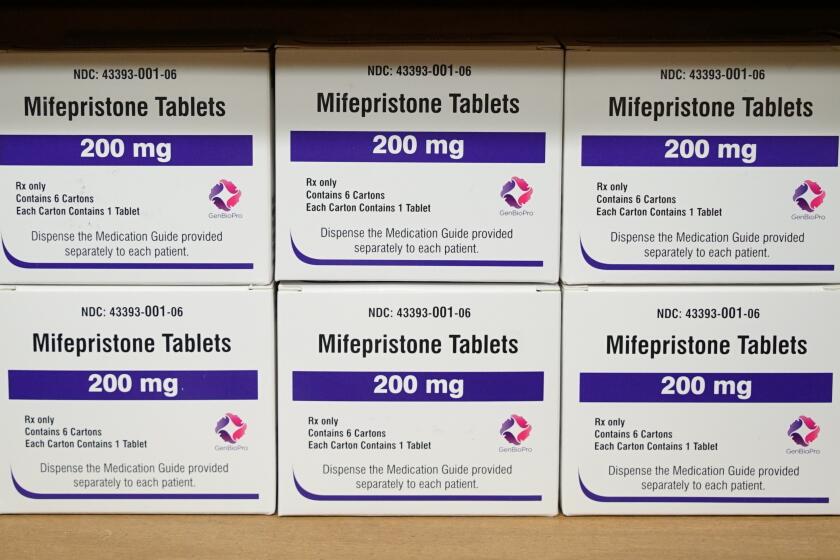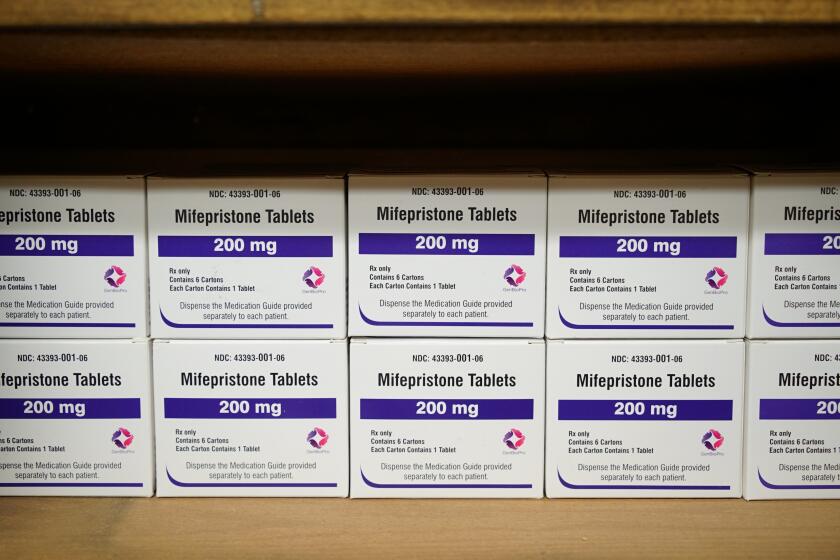Column: Who will make abortion pill rules? A bunch of right-wing judges or FDA scientists?

- Share via
Here we go again.
On Wednesday, the Supreme Court announced that it will decide whether the Food and Drug Administration has wrongly loosened the rules for abortion pills, which have been used safely for decades and now account for half of all U.S. abortions.
The case against the drug, mifepristone, was filed by a group of antiabortion physicians in a Texas federal court whose sole judge, U.S. District Judge Matthew Kacsmaryk, is known for his right-wing, anti-LGBTQ+, antiabortion bent.
The physicians could have filed in Maryland, where the FDA is based. They could have filed in any of the blue states where all kinds of abortion are legal.
But no.
They filed in Amarillo, Texas, where, to no one’s surprise, in April, the physicians won their case.
However, around the same time, a federal court in Washington state said exactly the opposite: The FDA had acted properly in 2016 when it extended the time for using mifepristone from seven weeks of pregnancy to 10, and in 2021, when it said that doctors did not have to see patients in person to prescribe the drug, and that it could be dispensed by mail.
The Supreme Court will decide whether to put stricter limits on abortion pills that are now the most common method for ending early pregnancies.
A few months later, a panel of appellate judges at the ultraconservative 5th Circuit Court of Appeals in New Orleans upheld part of Kacsmaryk’s ruling. The FDA’s original drug approval in 2000 could stand, the panel said, but the later modifications to how the drug could be prescribed and at what point in a pregnancy would be tossed.
With conflicting federal court rulings, the Supreme Court has stepped in to break the tie, probably next spring.
It’s quite possible that, having roiled the country with its indefensible Dobbs decision overturning Roe vs. Wade and allowing individual states to outlaw abortion, the justices will take a less radical stance this time around.
After all, the issue (ostensibly) is not whether abortion should or should not be legal. It’s whether the FDA followed its own rules when it modified how mifepristone can be used and prescribed.
Judge James Ho of the U.S. 5th Circuit Court of Appeals claimed mifepristone inflicts ‘aesthetic injury’ on doctors looking inside women’s bodies.
The plaintiffs in the case, the Alliance for Hippocratic Medicine, a consortium of Christian, antiabortion medical associations, claim that the FDA has endangered the lives of women and girls by letting “abortionists” give them “dangerous drugs” without proper review or study. Mifepristone, the group claims, helps sex traffickers and sex abusers “to force their victims into getting abortions while preventing the authorities from identifying these victims.”
That’s just a smidgen of the complaint’s overheated rhetoric.
Now, as we all know, the rules of regulatory agencies are dense thickets of jargon and impenetrable prose. So instead of looking at the FDA’s own rules, I carefully read a friend-of-the-court brief filed by 20 American food and drug law scholars, all of whom have what they describe as “deep expertise in the drug approval process.”
They were scathing.
The rulings from Kacsmaryk and the 5th Circuit, wrote the scholars, “rest on critical misunderstandings of federal food and drug law, and the underlying regulatory history for mifepristone” and “replace FDA’s scientific and medical expertise with the courts’ own interpretations of scientific evidence.”
Gov. Gavin Newsom announced a stockpile of 2 million abortion pills known as misoprostol after a Texas judge ruled against using a mifepristone, another medication to terminate pregnancies.
A decision reversing the FDA’s process on mifepristone, the scholars indicated, would throw the agency and indeed the entire pharmaceutical industry into chaos.
The FDA was cautious in approving and modifying rules about mifepristone. For example, contrary to what the antiabortion physicians claimed (and Kacsmaryk parroted), the FDA did examine data about whether mifepristone was associated with anxiety and depression. (It was not.)
Another of the abortion opponents’ claims is that the FDA wrongly expedited mifepristone’s original approval in 2000. “In fact,” wrote the scholars, “FDA took far longer than average to approve mifepristone.” The approval process took 54 months, compared with the agency’s average of 18 months for new drugs between 1996 and 2002.
And don’t be fooled by assertions that blocking access to mifespristone will keep women and girls safer. The physicians’ case is just one more disingenuous run at outlawing abortion in all 50 states.
With abortion care virtually inaccessible in 13 states, it’s imperative to remove barriers where it remains legal.
You must understand one thing above all else: Induced abortion, whether by surgery or medication, is much, much safer than carrying a pregnancy to term and going through childbirth.
How much safer?
In 2021, according to the Centers for Disease Control and Prevention, the maternal mortality rate was 32.9 per 100,000 live births. The number of women who died that year of “maternal causes,” as the CDC puts it, was 1,205. The number of deaths related to abortions, by contrast, is vanishingly small. In 2019, the last year for which the CDC has information, four women in the U.S. died due to complications from induced abortions.
Those years are not anomalies: “Legal induced abortion is markedly safer than childbirth,” wrote physician-researchers Elizabeth Raymond and David Grimes in a 2012 paper published by the journal Obstetrics and Gynecology. “The risk of death associated with childbirth is approximately 14 times higher than that with abortion.”
If the Supreme Court cares at all about facts and science underpinning government decision-making and regulations, and if it cares at all about the health and well-being of women and girls — so far, the jury is out on all these counts — it will uphold the FDA’s perfectly legal and sensible rules about abortion drugs, which have been safely used by more than 5 million American women since they were first approved nearly a quarter century ago.
More to Read
A cure for the common opinion
Get thought-provoking perspectives with our weekly newsletter.
You may occasionally receive promotional content from the Los Angeles Times.
















